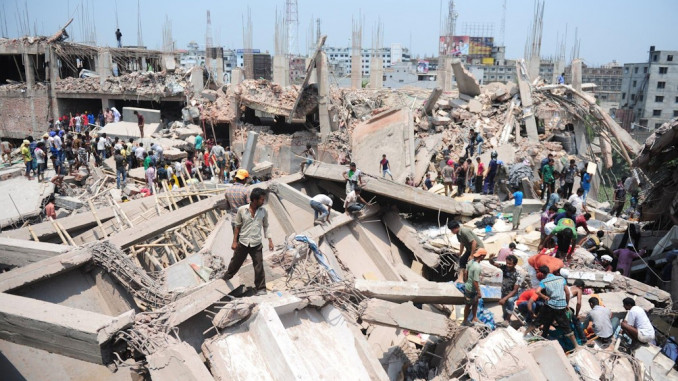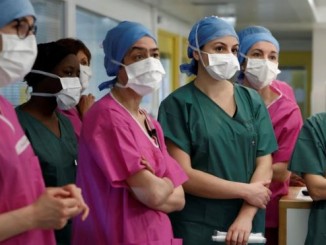
On April 24, 2013, the worst disaster in the history of the garment industry took place outside of Dhaka, Bangladesh. Rana Plaza, an eight-story commercial and manufacturing building, collapsed with thousands of workers inside, injuring about 2,500 and killing at least 1,127 mostly women workers. The story of the collapse is a textbook example of how workers suffer and die to make the profits enjoyed by only a few.
The building was originally supposed to be a four-story structure for retail and commercial use, not manufacturing. After using his political connections to get a permit to build one story higher than originally planned, the owner, Sohel Rana, added three more stories, without permits. When the collapse happened, he had already begun construction of a 9th floor, also unpermitted. Above the second floor, the building was being used exclusively for garment manufacturing, with larger machinery than would normally be used in non-manufacturing commerce. On those upper floors, about 5,000 workers were working on garments for many major global clothing brands and retail stores.
On April 23, cracks were noticed in the walls of the lower floors, and after being inspected by an engineer, the workers on those two floors were evacuated and allowed to stay home the next day. Workers for the garment companies, however, were told that the building was safe and that they should report to work as usual. The owner reassured the company owners that there was no need for further precautions. Most of the workers, compelled by their economic conditions to work as much as possible to earn enough money to sustain themselves and their families, reported to work as usual, despite their concerns. That morning, when a power outage occurred and workers turned on diesel generators to revive the power on the upper floors, the building shook and lurched before crumbling downward. Within moments, hundreds were dead, hundreds more trapped, and thousands injured.
The fact that 1,127 are dead is horrific enough, but many who survived, often considered the lucky ones, were also wounded for life. Some were paralyzed and maimed, many lost limbs, others now have long term internal nerve damage, some cannot have children, and more. Many now live impoverished lives with much pain and suffering.
Rana Plaza was only the worst in a list of deadly industrial accidents in Bangladesh in just the few years leading up to its collapse. We can put this pattern of worker deaths in Bangladesh in the context of an even longer list of earlier industrial disasters worldwide, in which hundreds or thousands of workers died: the Monongah mining disaster in 1907 West Virginia, the Triangle Shirtwaist Factory Fire in 1911 New York, the Laobaidong mine disaster in 1960 China, and the Bhopal chemical disaster in 1984 India, to name just a few. These disasters, while they don’t happen every day, are not abnormal. On the contrary, they are normal events within capitalist industrial society.
Rana Plaza and other accidents like it are in many ways easily avoidable. Better job options for workers, stricter construction codes, less political corruption, even a willingness to listen to inspectors could all have perhaps saved lives in this and many other cases. Looked at this way, most accidents at work are avoidable.
Building owners and garment company bosses do everything they do to make a profit. In doing so, they pursue the cheapest and most efficient means to produce the commodities they sell for that profit. This often means paying workers very little, or cutting workers’ pay. It often means giving workers as few extra benefits as possible. It often means making them work in unpleasant and unhealthy conditions. Sometimes it means building the factory as cheaply as possible, even if that means doing so illegally or otherwise cutting corners to reduce costs. This is what happened in the case of Rana Plaza. It was not caused by just a few bad apples or a few mistakes. The collapse, like so many other industrial disasters, was caused by the profit-driven logic of the system itself.
Today we remember the thousands who were injured and died in the Rana Plaza collapse. It is yet another example of the tragic loss of life that can be traced directly back to the imperatives of the capitalist economic system that shapes the world around us.




